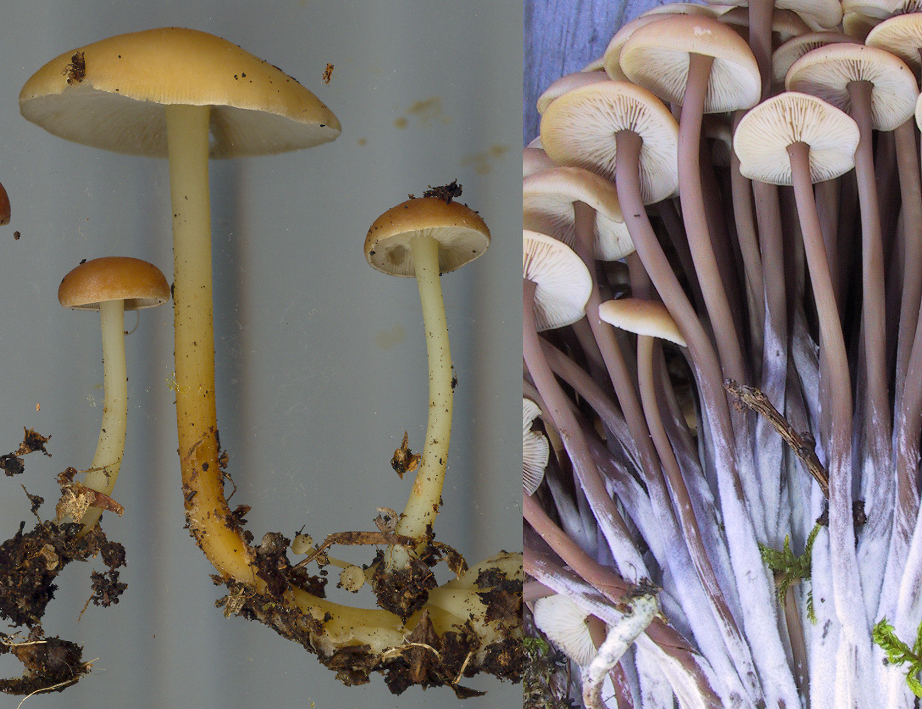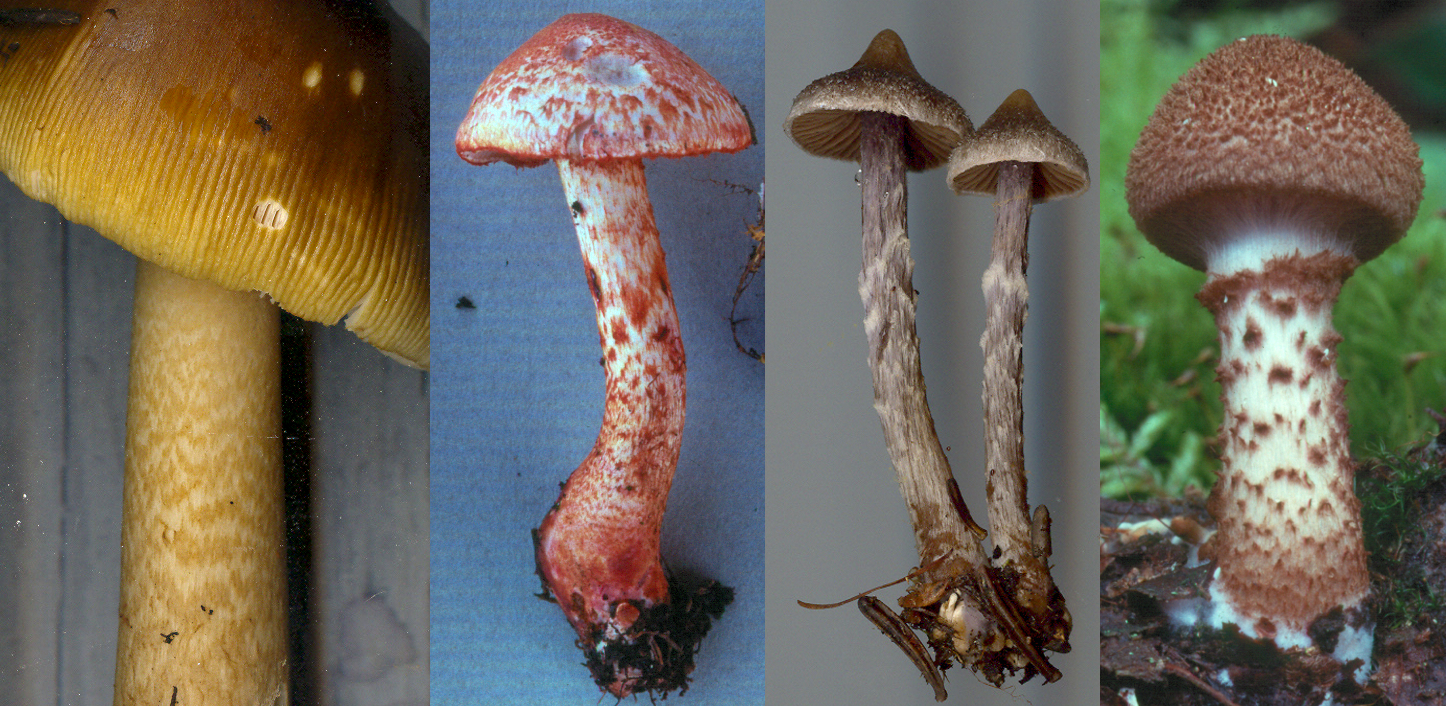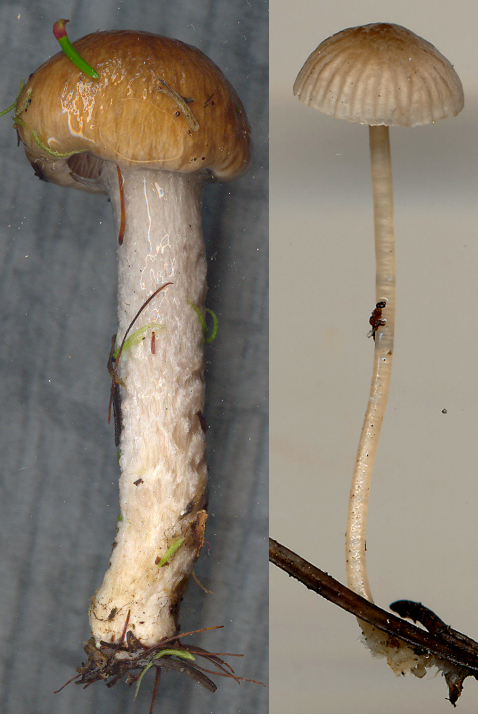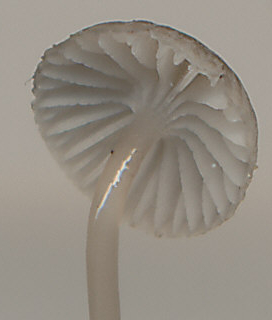STIPE TEXTURE

The texture of the stipe surface is used frequently in identifying mushrooms. Much of this detail is lost when the mushroom is dried, so it is necessary to record it for later reference while the collection is still fresh. The illustrations at right are of two species of Gymnopus, G. dryophilus and G. acervatus. The name Gymnopus is of Greek derivation and is a combination of gymno-, meaning naked, and -pus, meaning foot, referring to the naked or glabous stipe of many species in the genus. In G. dryophilus, pictured at near right, the stipe really is glabrous and polished in appearance, without any sort of hyphal attachments except at the extreme base where it is in contact with the soil. Gymnopilus acervatus, at far right, is also glabrous and polished in the upper parts but densely tomentose with white hyphae in the lower part. Most mushrooms will not have a stipe that is quite as glabrous as those of many Gymnopus species, but you will not usually have much difficulty differentiating those that are glabrous or nearly so from the more highly ornamented types figured below.

Many mushrooms have some kind of decoration or vestiture on their stipes that are characteristic of their species. The mushrooms in the pictures above show increasingly obvious types of scales. The species of Amanita, above left, has a stipe with finely appressed scales that contrast in colour with the tissues below them. These scales are an innate characteristic of the stipe surface and differ in origin from the three species of Cortinarius to the right, which all have scales made up of remnants of the universal veil. In C. bolaris, second to left, the scales are tightly appressed like those of the Amanita but are also present on the surface of the pileus. The scales in C. decipiens, second to right, form cottony rings or bands along the lower 3/4 of the stipe. In C. pholideus The scales stand out prominently from the stipe in a manner described as squarrose
.In all of the examples illustrated above the stipe is dry or at best a little moist in wet weather. However, some mushrooms have stipes that or quite slimy or viscid.

 In Cortinarius mucifluus, at far left, the slime is clearly visible on the upper part of the stipe and also on the pileus. Species of Cortinarius with stipe and pileus both viscid are assigned to Cortinarius subgenus Myxacium. Note also that the stipe of this mushroom is not only viscid but is densely tomentose or wooly on its surface.
In Cortinarius mucifluus, at far left, the slime is clearly visible on the upper part of the stipe and also on the pileus. Species of Cortinarius with stipe and pileus both viscid are assigned to Cortinarius subgenus Myxacium. Note also that the stipe of this mushroom is not only viscid but is densely tomentose or wooly on its surface.
The mushroom to the right of Cortinarius mucifluus is Mycena vulgaris one of several Mycena species characterized by viscid stipes. Although the viscid layer is not particularly obvious in the picture it can be seen in the more highly magnified picture at left of another fruiting body from the same collection. The inconspicuous slime lay can be misleading; these species probably have the slipperiest stipes of all mushrooms. I have many times taken hold of the stipe to pick the mushroom for a closer look only to have my fingers slide right to the top, removing the cap. The only way to collect them without damage is to remove the substrate and all from the ground.
The difference in size beween Cortinarius mucifluus and Mycena vulgaris may not be obvious in the pictures and can only be appreciated by looking closely at the plant material attached to each fruiting body. In the picture of C. mucifluus you can see a few thin brown needles of larch still attached, along with two thicker fir needles. The "large" brown structure at the base of Mycena vulgaris is in fact a single fir needle.